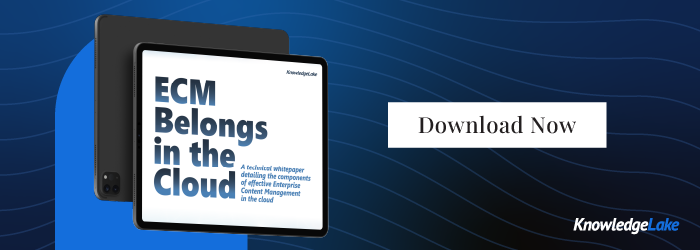ECM modernization — and along with it, ECM data migration — is on the menu for most organizations these days. Cloud technology has matured to the point where it offers far more stability, flexibility, security, and compliance than aging legacy ECM systems. Thus the accelerating rise in organizations moving their ECM to the cloud.
In fact, the cloud ECM market is projected to grow into a $97 billion industry by 2026. But upgrading or modernizing your ECM can be a daunting undertaking, especially if you’ve been burned by lift and shift migrations in the past. We recommend breaking the process down into smaller, more manageable phases to create a strategy that sets your modernization project up for success.
Modernizing your ECM can be broken down into four main phases:
-
Evaluation
Before moving any content to the cloud, you’ll first need to identify exactly what content exists in your legacy system. Identifying content that can be archived or deleted can drastically simplify your migration if it means leaving behind obsolete data. For instance, we find that many of our customers are just fine leaving behind a lot of (if not most of) their outdated documents and other content.
You should also conduct a thorough audit of your existing content infrastructure. This includes establishing a clear overview of file types and metadata from each system to prepare for metadata mapping. This will help to anticipate any desired changes to file classification and tagging schemes. Before changing existing data assets, you should build those changes into the new cloud-based ECM solution. ECM data migration, in fact, can help you achieve a cleaner, more accurate, and more searchable information architecture.
-
Developing a Plan
We know from experience that only about 20% of any new ECM initiative is truly about the software involved. The other 80% is about strategy, planning, training, and ongoing maintenance.
A well-thought-out change management plan will make for a more manageable ECM data migration. By controlling the lifecycle of all changes, you can minimize disruption to existing business processes and IT.
A good plan should outline all aspects of the migration, from installation to implementation. Keeping users involved in this phase is crucial to ensuring high user adoption. They must be informed well upstream of the initiative, timelines, and long-term benefits of the migration project. Upfront communication is key to sowing the seeds of long-term success.
-
Mapping ECM Content Lifecycles and Workflows
Data assets have a life cycle. They can be created, modified, stored for a certain period, and then archived or deleted.
Understanding these assets, and who is responsible for them, will inform the migration team of the role of each business stakeholder in the migration of different assets.
The mapping phase provides the link to the destination system, creating item-by-item mappings from source to destination. The creation of schema mappings streamlines the process and can inform administrative tasks, such as syncing users, groups, and role mappings between systems.
-
Act with a Practical Roadmap
Modern organizations maintain hundreds of thousands of information assets. Migrations can be resource-intensive and costly for companies. Having a plan is the second step above. How you execute that plan is just as (if not more) important.
Move forward with an iterative roadmap based on proven best practices. This will help mitigate costly risks while ensuring that tasks are completed on budget and on time. For example, smaller organizations that lack the resources to conduct a complete one-stop migration should first focus on high-priority information assets. Prioritizing different departments and business functions can help set the direction for larger organizations.
We also recommend working with an experienced and trusted partner to establish a clear migration roadmap. This will help solidify the iterative process to move all data assets and users of those data assets to the new, cloud-based ECM system.
Modernizing your ECM is a complex undertaking. But by creating and following a plan of attack informed by best practices, modernization is well within reach—for enterprises as well as small to medium-sized companies.
Check out our white paper, “ECM Belongs in the Cloud,” to learn more about the steps of a successful ECM modernization project.

